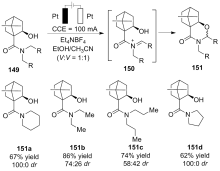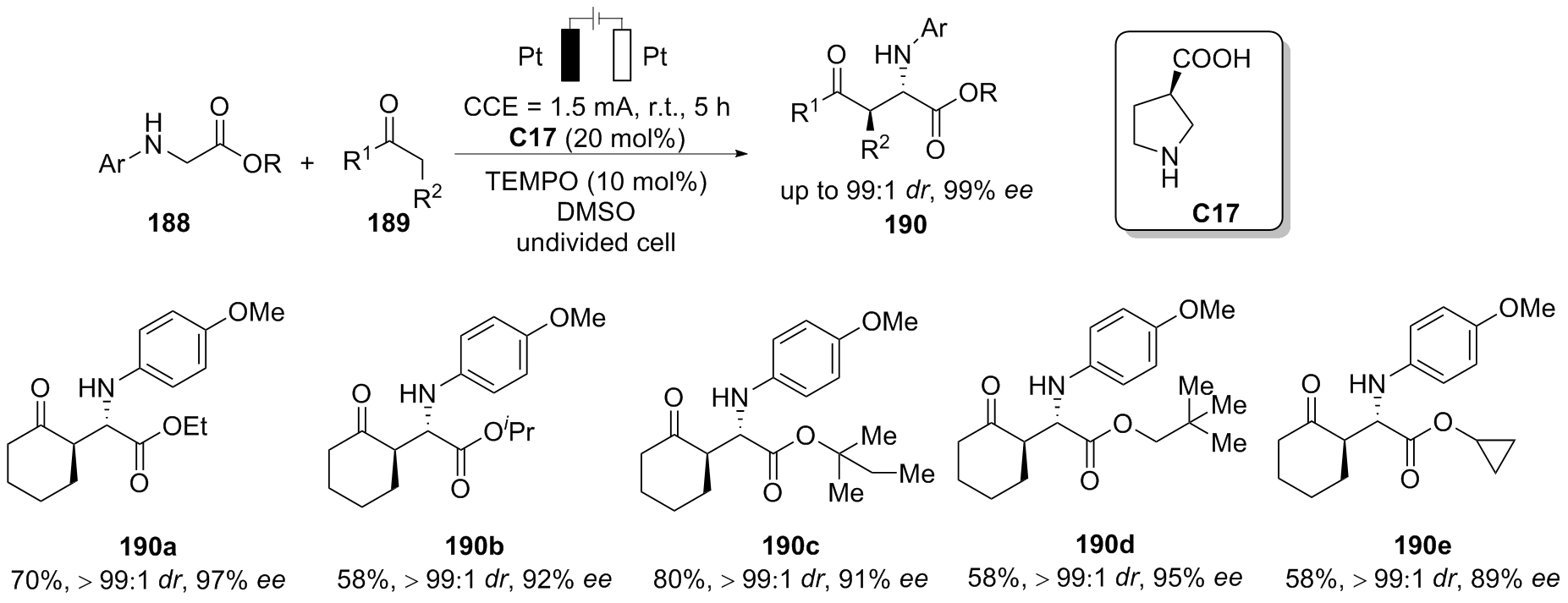有机化学 ›› 2024, Vol. 44 ›› Issue (3): 748-779.DOI: 10.6023/cjoc202311004 上一篇 下一篇
所属专题: 光电催化综述合集
综述与进展
陈远航, 何劲宇, 张博, 王延钊, 孔令轩, 钱伟烽, 王娜娜, 段闻喜, 欧阳妍妍, 朱翠菊*( ), 徐浩*(
), 徐浩*( )
)
收稿日期:2023-11-03
修回日期:2024-01-23
发布日期:2024-04-02
作者简介:共同第一作者
基金资助:
Yuanhang Chen, Jinyu He, Bo Zhang, Yanzhao Wang, Lingxuan Kong, Weifeng Qian, Na'na Wang, Wenxi Duan, Yanyan Ouyang, Cuiju Zhu( ), Hao Xu(
), Hao Xu( )
)
Received:2023-11-03
Revised:2024-01-23
Published:2024-04-02
Contact:
*E-mail: cuiju.zhu@ccnu.edu.cn; hao.xu@ccnu.edu.cn
About author:These authors contributed equally to this work.
Supported by:文章分享

有机电化学合成可以追溯到19世纪, 其发展历史悠久. 而将不对称催化和有机电化学合成结合开辟新的合成方法, 已逐渐成为合成手性化合物的重要途经之一. 因此, 不对称电化学合成吸引了众多有机合成研究者的关注, 在近几十年间, 不对称电化学合成发展迅速且成效卓越, 已成为新兴领域. 不对称电合成可以突破传统合成的限制, 通过调节电流、电压以改变反应的选择性, 甚至开发出传统合成方法无法实现的策略, 并且具备温和高效、绿色环保等优势. 目前, 不对称电化学已与有机小分子催化、金属催化、光催化、酶催化等领域相结合, 在合成具有药物活性分子等方面有着巨大潜力, 但不对称电化学的发展仍有许多局限性, 探索新的电化学不对称催化体系仍然有巨大的挑战性, 还有很多未知需要探索. 基于此, 本文总结了近二十年不对称电化学的进展, 依据催化剂类型不同, 分为金属电化学还原不对称催化、金属电化学氧化不对称催化、有机电化学还原不对称催化及有机电化学氧化不对称催化四个方面介绍不对称电化学的研究成果.
陈远航, 何劲宇, 张博, 王延钊, 孔令轩, 钱伟烽, 王娜娜, 段闻喜, 欧阳妍妍, 朱翠菊, 徐浩. 不对称电化学有机合成[J]. 有机化学, 2024, 44(3): 748-779.
Yuanhang Chen, Jinyu He, Bo Zhang, Yanzhao Wang, Lingxuan Kong, Weifeng Qian, Na'na Wang, Wenxi Duan, Yanyan Ouyang, Cuiju Zhu, Hao Xu. Asymmetric Electrochemical Organic Synthesis[J]. Chinese Journal of Organic Chemistry, 2024, 44(3): 748-779.
















| [1] |
Frontana-Uribe B. A.; Little R. D.; Ibanez J. G.; Palma A.; Vasquez-Medrano R. Green Chem. 2010, 12, 2099.
doi: 10.1039/c0gc00382d |
| [2] |
(a) Wiebe A.; Gieshoff T.; Mohle S.; Rodrigo E.; Zirbes M.; Waldvogel S. R. Angew. Chem., Int. Ed. 2018, 57, 5594.
doi: 10.1002/anie.v57.20 |
|
(b) Guo S.-P.; Liu L.-Y.; Hu K.-F.; Sun Q.; Zha Z.-G.; Yang Y.; Wang Z.-Y. Chin. Chem. Lett. 2021, 32, 1033.
doi: 10.1016/j.cclet.2020.09.041 |
|
|
(c) He W.-B.; Zhao S.-J.; Chen J.-Y.; Jiang J.; Chen X.; Xu X.-H.; He W.-M. Chin. Chem. Lett. 2023, 34, 107640.
doi: 10.1016/j.cclet.2022.06.063 |
|
|
(d) Yang Z.-X.; Lai L.-C.; Chen J.-Z.; Yan H.; Chen F.-E. Chin. Chem. Lett. 2023, 34, 107956.
doi: 10.1016/j.cclet.2022.107956 |
|
| [3] |
(a) Yan M.; Kawamata Y.; Baran P. S. Chem. Rev. 2017, 117, 13230.
doi: 10.1021/acs.chemrev.7b00397 |
|
(b) Li J.-J.; Zhang S.; Xu K. Chin. Chem. Lett. 2021, 32, 2729.
doi: 10.1016/j.cclet.2021.03.027 |
|
| [4] |
Martins G. M.; Shirinfar B.; Hardwick T.; Ahmed N. ChemElectroChem 2019, 6, 1300.
doi: 10.1002/celc.v6.5 |
| [5] |
Wang X.-Y.; Wang Z.-H.; Fang P.; Mei T.-S. Chin. J. Org. Chem. 2020, 40, 3738. (in Chinese)
doi: 10.6023/cjoc202003022 |
|
( 王向阳, 徐学涛, 王振华, 方萍, 梅天胜, 有机化学, 2020, 40, 3738.)
doi: 10.6023/cjoc202003022 |
|
| [6] |
Fu N.-K.; Song L.; Liu J.-J.; Shen Y.-F.; Siu J.-C.; Lin S. J. Am. Chem. Soc. 2019, 141, 14480.
doi: 10.1021/jacs.9b03296 |
| [7] |
Wang Z.-H.; Gao P.-S.; Wang X.; Gao J.-Q.; Xu X.-T.; He Z.; Ma C.; Mei T.-S. J. Am. Chem. Soc. 2021, 143, 15599.
doi: 10.1021/jacs.1c08671 |
| [8] |
(a) Zhang Q.-L.; Chang X.-H.; Peng L.-Z.; Guo C. Angew. Chem. 2019, 131, 7073.
doi: 10.1002/ange.v131.21 |
|
(b) Zhang Q.-L.; Liang K.; Guo C. Angew. Chem. Int. Ed. 2022, 61, e202210632.
doi: 10.1002/anie.v61.38 |
|
|
(c) Zhang Q.-L.; Liang K.; Guo C. CCS Chem. 2021, 3, 338.
doi: 10.31635/ccschem.021.202000720 |
|
|
(d) Liang K.; Zhang Q.-L.; Guo C. Sci. Adv. 2022, 8, eadd7134.
doi: 10.1126/sciadv.add7134 |
|
|
(e) Liang K.; Zhang Q.-L.; Guo C. Nat. Synth. 2023, 2, 1184.
doi: 10.1038/s44160-023-00372-w |
|
| [9] |
Zhou G.; Chen J.-H.; Yao Q.-J.; Huang F.-R.; Wan Z.-K.; Shi B.-F. Angew. Chem. Int. Ed. 2023, 62, e202302964.
doi: 10.1002/anie.v62.21 |
| [10] |
(a) Münchow T.; Dana S.; Xu Y.; Yuan B.-B.; Ackermann L. Science 2023, 379, 1036.
doi: 10.1126/science.adg2866 |
|
(b) Dhawa U.; Tian C.; Wdowik T.; Oliveira J.C.A.; Hao J.-P.; Ackermann L. Angew. Chem. Int. Ed. 2020, 59, 13451.
doi: 10.1002/anie.v59.32 |
|
| [11] |
Franco D.; Riahi A.; Hénin F.; Muzart J.; Duñach E. Eur. J. Org. Chem. 2002, 14, 2257.
|
| [12] |
Magdesieva T. V.; Levitskiy O. A.; Grishin Y. K.; Ambartsumyan A. A.; Kiskin M. A. Organometallics 2014, 33, 4629.
doi: 10.1021/om500070n |
| [13] |
DeLano T. J.; Reisman S. E. ACS Catal. 2019, 9, 6751.
doi: 10.1021/acscatal.9b01785 |
| [14] |
Qiu H.; Shuai B.; Wang Y.-Z.; Liu D.; Chen Y.-G.; Gao P.-S.; Ma H.-X.; Chen S.; Mei T.-S. J. Am. Chem. Soc. 2020, 142, 9872.
doi: 10.1021/jacs.9b13117 |
| [15] |
Wang Y.-Z.; Wang Z.-H.; Eshel I. L.; Sun B.; Liu D.; Gu Y.-C.; Milo A.; Mei T.-S. Nat. Commun. 2023, 14, 2322.
doi: 10.1038/s41467-023-37965-0 |
| [16] |
Sun B.; Wang Z.-H.; Wang Y.-Z.; Gu Y.-C.; Ma C.; Mei T.-S. Sci. Bull. 2023, 68, 2033.
doi: 10.1016/j.scib.2023.07.007 |
| [17] |
Chen B.-L.; Zhu H.-W.; Xiao Y.; Sun Q.-L.; Wang H.; Lu J.-X. Electrochem. Commun. 2014, 42, 55.
doi: 10.1016/j.elecom.2014.02.009 |
| [18] |
Gao S.-G.; Wang C.; Yang J.-F.; Zhang J.-L. Nat. Commun. 2023, 14, 1301.
doi: 10.1038/s41467-023-36704-9 |
| [19] |
Jiao K.-J.; Li Z.-M.; Xu X.-T.; Zhang L.-P.; Li Y.-Q.; Zhang K.; Mei T.-S. Org. Chem. Front. 2018, 5, 2244.
doi: 10.1039/C8QO00507A |
| [20] |
Ding W.-J.; Li M.-F.; Fan J.-K.; Cheng X. Nat. Commun. 2022, 13, 5642.
doi: 10.1038/s41467-022-33452-0 |
| [21] |
Höllrigl V.; Otto K.; Schmid A. Adv. Synth. Catal. 2007, 349, 1337.
doi: 10.1002/adsc.v349:8/9 |
| [22] |
Torii S.; Liu P.; Bhuvaneswari N.; Amatore C.; Jutand A. J. Org. Chem. 1996, 61, 3055.
doi: 10.1021/jo952137r |
| [23] |
Tanaka H.; Kuroboshi M.; Takeda H.; Kanda H.; Torii S. J. Electroanal. Chem. 2001, 507, 75.
doi: 10.1016/S0022-0728(01)00387-4 |
| [24] |
Huang X.-Q.; Zhang Q.; Lin J.-H.; Harms K. ; Meggers E. Nat. Catal. 2019, 2, 34.
doi: 10.1038/s41929-018-0198-y |
| [25] |
Xiong P.; Marcel H.; Ivlev S. I.; Meggers E. J. Am. Chem. Soc. 2022, 144, 6964.
doi: 10.1021/jacs.2c01686 pmid: 35385651 |
| [26] |
Huang Y.-Q.; Wu Z.-J.; Zhu L.; Gu Q.; Lu X.-J.; You S.-L.; Mei T.-S. CCS Chem. 2022, 4, 3181.
doi: 10.31635/ccschem.021.202101376 |
| [27] |
Minato D.; Arimoto H.; Nagasue Y.; Demizu Y.; Onomura O. Tetrahedron 2008, 64, 6675.
doi: 10.1016/j.tet.2008.05.015 |
| [28] |
Gao P.-S.; Weng X.-J.; Wang Z.-H.; Zheng C.; Sun B.; Chen Z.-H.; You S.-L.; Mei T.-S. Angew. Chem. Int. Ed. 2020, 59, 15254.
doi: 10.1002/anie.v59.35 |
| [29] |
(a) Cai C.-Y.; Lai X.-L.; Wang Y.; Hu H.-H.; Song J.-S.; Yang Y.; Wang C.; Xu H.-C. Nat. Catal. 2022, 5, 943.
doi: 10.1038/s41929-022-00855-7 |
|
(b) Fan W.-Z.; Zhao X.-Y.; Deng Y.-S.; Chen P.-H.; Wang F.; Liu G.-S. J. Am. Chem. Soc. 2022, 47, 21674.
|
|
| [30] |
Lai X.-L.; Chen M.; Wang Y.-Q.; Song J.-S.; Xu H.-C. J. Am. Chem. Soc. 2022, 144, 20201.
doi: 10.1021/jacs.2c09050 |
| [31] |
Lai X.-L.; Xu H.-C. J. Am. Chem. Soc. 2023, 145, 18753.
doi: 10.1021/jacs.3c07146 |
| [32] |
Kise N.; Iwasaki K.; Tokieda N.; Ueda N. Org. Lett. 2001, 3, 3241.
pmid: 11594804 |
| [33] |
Palombi L.; Feroci M.; Orsinia M.; Inesi A. Tetrahedron 2002, 13, 2311.
|
| [34] |
(a) Feroci M.; Inesi A.; Orsini M.; Palombi L. Org. Lett. 2002, 4, 2617.
pmid: 14725464 |
|
(b) Feroci M.; Orsini M.; Palombi L.; Sotgiu G.; Colapietro M.; Inesi A. J. Org. Chem. 2004, 69, 487.
pmid: 14725464 |
|
| [35] |
Zhang K.; Wang H.; Zhao S.-F.; Niu D.-F.; Lu J.-X. J. Electroanal. Chem. 2009, 630, 35.
doi: 10.1016/j.jelechem.2009.02.013 |
| [36] |
Lütz S.; Steckhan E.; Liese A. Electrochem. Commun. 2004, 6, 583.
doi: 10.1016/j.elecom.2004.04.009 |
| [37] |
Hollmann F.; Hofstetter K.; Habicher T.; Hauer B.; Schmid A. J. Am. Chem. Soc. 2005, 127, 6540.
doi: 10.1021/ja050997b pmid: 15869268 |
| [38] |
Feroci M. Adv. Synth. Catal. 2007, 349, 2177.
doi: 10.1002/adsc.v349:13 |
| [39] |
Yang H.-P.; Lv T.; Sun W.-W.; Du Y.-F.; Wang H.; Lu J.-X. RSC Adv. 2014, 4, 30584.
doi: 10.1039/C4RA03368J |
| [40] |
Yue Y.-N.; Wu D.; Zeng S.; Yang M.-P.; Wang H.; Lu J.-X. New J. Chem. 2017, 41, 7853.
doi: 10.1039/C7NJ00844A |
| [41] |
Chen H.; Cai R.; Patel J.; Dong F.-Y.; Chen H.; Minteer S.D. J. Am. Chem. Soc. 2019, 141, 4963.
doi: 10.1021/jacs.9b00147 pmid: 30835461 |
| [42] |
Wang Z.-L.; Zhao Y.-J.; Xiong R.; Yang L.-R.; Wang H.; Lu J.-X. ChemistrySelect 2021, 6, 876.
doi: 10.1002/slct.v6.4 |
| [43] |
(a) Osa T.; Kashiwagi Y.; Yanagisawa Y.; Bobbitt J. M. J. Chem. Soc. Chem. Commun. 1994, 2535.
|
|
(b) Kashiwagi Y.; Yanagisawa Y.; Kurashima F.; Bobbitt J. M. Chem. Commun. 1996, 2745.
|
|
|
(c) Yanagisawa Y.; Kashiwagi Y.; Kurashima F.; Bobbitt J. M. Chem. Lett. 1996, 25, 1043.
doi: 10.1246/cl.1996.1043 |
|
| [44] |
Maekawa H.; Itoh K.; Goda S.; Nishiguchi I. Chirality 2003, 15, 95.
doi: 10.1002/chir.v15:1 |
| [45] |
Sierecki E.; Turcaud S.; Royer J.; Martens T. Synthesis 2006, 19, 3199.
|
| [46] |
Page P.C.B.; Marken F.; Williamson C.; Chan Y.; Buckley B.R.; Bethell D. Adv. Synth. Catal. 2008, 350, 1149.
doi: 10.1002/adsc.v350:7/8 |
| [47] |
Shiigi H.; Mori H.; Tanaka T.; Demizu Y.; Onomura O. Tetrahedron Lett. 2008, 49, 5247.
|
| [48] |
Lee D.-S. Tetrahedron 2009, 20, 2014.
|
| [49] |
D'Oca, M. G. M.; Pilli, R. A.; Vencato, I. Tetrahedron Lett. 2000, 41, 9709.
doi: 10.1016/S0040-4039(00)01749-4 |
| [50] |
Jensen K. L.; Franke P. T.; Nielsen L. T.; Daasbjerg K.; Jørgensen K. A. Angew. Chem. Int. Ed. 2010, 49, 129.
doi: 10.1002/anie.200904754 pmid: 19946923 |
| [51] |
Bui N.-N.; Ho X.-H.; Mho S.; Jang H.-Y. Eur. J. Org. Chem. 2009, 5309.
|
| [52] |
Ho X.-H.; Mho S.-I.; Kang H.; Jang H.-Y. Eur. J. Org. Chem. 2010, 4436.
|
| [53] |
Fu N.-K.; Li L.-J.; Yang Q.; Luo S.-Z. Org. Lett. 2017, 19, 2122.
doi: 10.1021/acs.orglett.7b00746 |
| [54] |
Gao W.-C.; Xiong Z.-Y.; Pirhaghani S.; Wirth T. Synthesis 2019, 51, 276.
doi: 10.1055/s-0037-1610373 |
| [55] |
Li L.-J.; Li Y.; Fu N.-K.; Zhang L.; Luo S.-Z. Angew. Chem. Int. Ed. 2020, 59, 14347.
doi: 10.1002/anie.v59.34 |
| [56] |
Lu F.-Y.; Chen Y.-J.; Chen Y.; Ding X.; Guan Z.; He Y.-H. Chem. Commun. 2020, 56, 623.
doi: 10.1039/C9CC09178E |
| [57] |
Chang X.-H.; Zhang J.-Y.; Zhang Q.-L.; Guo C. Angew. Chem. Int. Ed. 2020, 59, 18500.
doi: 10.1002/anie.v59.42 |
| [1] | 靳瑞文, 王连杰, 宋跃, 刘小培, 王俊伟, 李中贤. 基于成环策略构建苯并呋喃的合成研究[J]. 有机化学, 2024, 44(9): 2742-2759. |
| [2] | 高宇珅, 高媛媛, 张安安, 李路, 耿巍芝, 张凤华, 李飞, 刘澜涛. BF3•OEt2介导2-炔基苯胺的分子内环化反应合成3-硫醚吲哚化合物[J]. 有机化学, 2024, 44(9): 2785-2795. |
| [3] | 曾涛, 张曙盛, 付建国, 冯陈国. 防风中亥茅酚及亥茅酚苷的不对称合成[J]. 有机化学, 2024, 44(9): 2862-2868. |
| [4] | 赵明, 颜瑞, 陈虎. 氮杂环卡宾催化醛类化合物的极性反转[J]. 有机化学, 2024, 44(7): 2204-2215. |
| [5] | 陆玲依, 邱晓东. 自由基形式烯烃双烷基化反应研究进展[J]. 有机化学, 2024, 44(6): 1701-1718. |
| [6] | 梁蕾蕾, 姚家灿, 丁凡, 徐畅, 刘丹丹. 水鬼蕉碱Pancratistatin的合成方法研究进展[J]. 有机化学, 2024, 44(6): 1793-1810. |
| [7] | 万云辉, 杨福美, 陈明瀚, 孙德立, 叶丹锋. 无过渡金属催化的N-苄基-N-叔丁氧羰基酰胺与不饱和醇的酯化反应[J]. 有机化学, 2024, 44(4): 1293-1300. |
| [8] | 李晨龙, 余志祥. 一氧化碳参与的过渡金属催化的插羰环加成反应研究进展[J]. 有机化学, 2024, 44(4): 1045-1068. |
| [9] | 郭凯杰, 符昕姝, 李靖, 陈艳, 胡美丽, 堵锡华, 谢屿阳, 何燕. 过渡金属催化C—S键活化与转化研究进展[J]. 有机化学, 2024, 44(4): 1124-1150. |
| [10] | 鞠国栋, 周冠宇, 赵应声. 三异丙基硅烷(TIPS)保护苯酚的无过渡金属催化区域选择性硫氰化反应[J]. 有机化学, 2024, 44(4): 1327-1336. |
| [11] | 彭天凤, 赵玉祥, 浦绍健, 罗娟, 刘腾, 缪应纯, 沈先福. 过渡金属催化的关键反应在异戊烯基吲哚生物碱全合成中的研究进展[J]. 有机化学, 2024, 44(4): 1160-1180. |
| [12] | 王竣永, 李娜, 柯杰, 何川. 电化学硅基化反应的研究进展[J]. 有机化学, 2024, 44(3): 927-939. |
| [13] | 孙雪, 颜廷涛, 闫克鲁, 杨建静, 文江伟. 电化学促使α-重氮酯的磷酸化构筑亚膦酸腙[J]. 有机化学, 2024, 44(3): 1013-1020. |
| [14] | 李章健, 王振华, 郭剑峰, 方萍, 马聪, 刘润华, 梅天胜. 电化学促进2,2,6,6-四甲基哌啶氧化物(TEMPO)介导的甘氨酸衍生物氧化脱氢Povarov/串联反应[J]. 有机化学, 2024, 44(3): 940-950. |
| [15] | 高淳, 刘欣, 王明慧, 刘淑贤, 朱婷婷, 张怡康, 郝二军, 杨启亮. 电化学不对称合成反应的研究进展[J]. 有机化学, 2024, 44(3): 673-727. |
| 阅读次数 | ||||||
|
全文 |
|
|||||
|
摘要 |
|
|||||